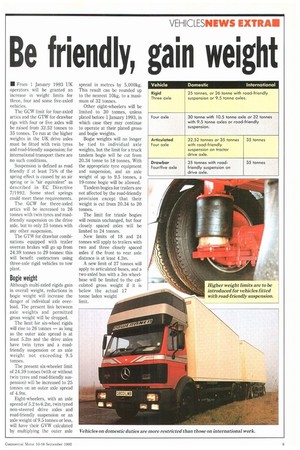Be friendly, gain weight
Page 11

If you've noticed an error in this article please click here to report it so we can fix it.
• From 1 January 1993 UK operators will be granted an increase in weight limits for three, four and some five-axled vehicles.
The GCW limit for four-axled artics and the GTW for drawbar rigs with four or five axles will be raised from 32.52 tonnes to 35 tonnes. To run at the higher weights in the UK drive axles must be fitted with twin tyres and road-friendly suspension; for international transport there are no such conditions.
Suspension is defined as road friendly if at least 75% of the spring effect is caused by an air spring or is "air equivalent" as described in EC Directive 7/1992. Some steel springs could meet these requirements.
The GCW for three-axled artics will be increased to 26 tonnes with twin tyres and roadfriendly suspension on the drive axle, but to only 25 tonnes with any other suspension.
The GTW for drawbar combinations equipped with trailer overrun brakes will go up from 24.39 tonnes to 29 tonnes: this will benefit contractors using three-axle rigid vehicles to tow plant.
Bogie weight
Although multi-axled rigids gain in overall weight, reductions in bogie weight will increase the danger of individual axle overload. The present link between axle weights and permitted gross weight will be dropped.
The limit for six-wheel rigids will rise to 26 tonnes — as long as the outer axle spread is at least 5.2m and the drive axles have twin tyres and a roadfriendly suspension or an axle weight not exceeding 9.5 tonnes.
The present six-wheeler limit of 24.39 tonnes (with or without twin tyres and road-friendly suspension) will be increased to 25 tonnes on an outer axle spread of 4.9m.
Eight-wheelers, with an axle spread of 5.2 to 6.2m, twin tyred non-steered drive axles and road-friendly suspension or an axle weight of 9.5 tonnes or less, will have their GVW calculated by multiplying the outer axle spread in metres by 5,000kg. This result can be rounded up to the nearest 10kg, to a maximum of 32 tonnes.
Other eight-wheelers will be limited to 30 tonnes, unless plated before 1 January 1993, in which case they may continue to operate at their plated gross and bogie weights.
Bogie weights will no longer be tied to individual axle weights, but the limit for a truck tandem bogie will be cut from 20.34 tonne to 18 tonnes. With the appropriate tyre equipment and suspension, and an axle weight of up to 9.5 tonnes, a 19-tonne bogie will be allowed.
Tandem bogies for trailers are not affected by the road-friendly provision except that their weight is cut from 20.34 to 20 tonnes.
The limit for triaxle bogies will remain unchanged, but four closely spaced axles will be limited to 24 tonnes.
New limits of 18 and 24 tonnes will apply to trailers with two and three closely spaced axles if the front to rear axle distance is at least 4.2m.
A new limit of 27 tonnes will apply to articulated buses, and a two-axled bus with a 3m wheelbase will be limited to the calculated gross weight if it is below the actual 17 tonne laden weight limit.




















































































